#burn my clothes
Text


Unnecessarily Complex Fit
Inktober Day 3 is for Hope!Hob who made the mistake of letting his ridiculous stranger pick his Hope threads rip (look its unnecessarily complex for Hob, and also me, because I am a tired worm)
#also some knight of the dreaming vibes#inktober#cringetober#inktober2023#cringetober 2023#the sandman#the sandman netflix#dreamling#hob gadling#hope of the endless#hope!hob#dream of the endless#morpheus#matthew the raven#im only 5 hours late hush#also i really really hate drawing clothing/armor so#this was my nightmare#i know dream usually gets the flame! cloak but Hope is a burning thing#my art#digital art#if i make hobs hair a lighter brown every time i draw him thats my business#its his hope glow or something leave me alone
3K notes
·
View notes
Note
manifesting a blaze scar in your askbox for the fanon swap game pretty please 🙏
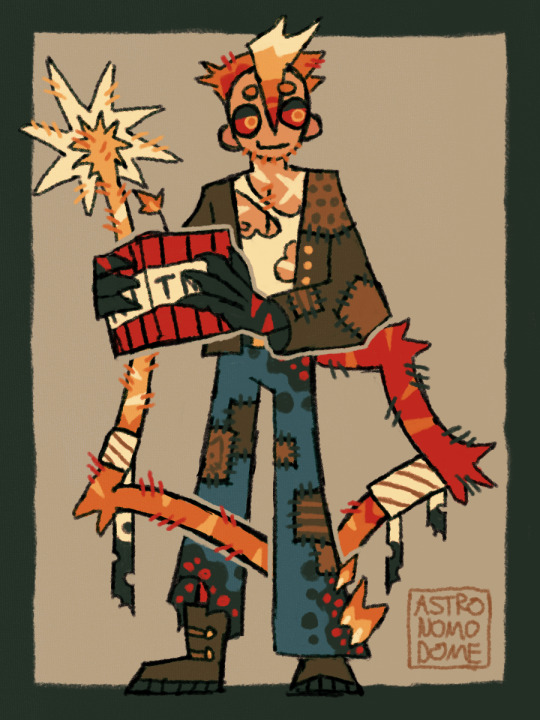
tried to make it look like scar instead of tango with a new haircut, i hope it comes across? lol
725 notes
·
View notes
Text
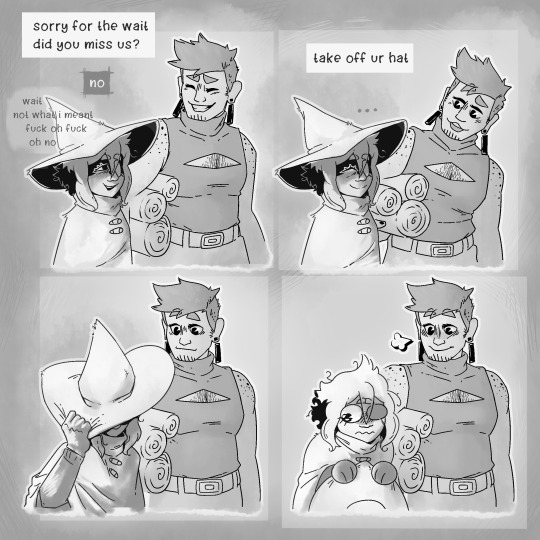
sometimes you sound bit too mean, it happens

it was Supposed to be in colour, and them the bw version Just Looked better
this is mostly based on this meme

#biggest thanks to the person in the discord who just i guess had this screenshot On Hands?? i would not be able to find it#kinda feel like im burning out with art#should take a rest probably#isat#in stars and time#is this spoilers??? probably not??? maybe??? will tag in case#isat spoilers#isat siffrin#isat isabeau#is mostly there as eye candy#any one of the party members could be there#the attitudes would be different tho#i like having at least a vague sense of blackstory for things like this so isa has just finished shopping for fabricks#a long and arduous process in my experience#i feel so bad that i cant draw stylish clothes isa deserves better but i am supremely unfashionable#my art#comic
353 notes
·
View notes
Text
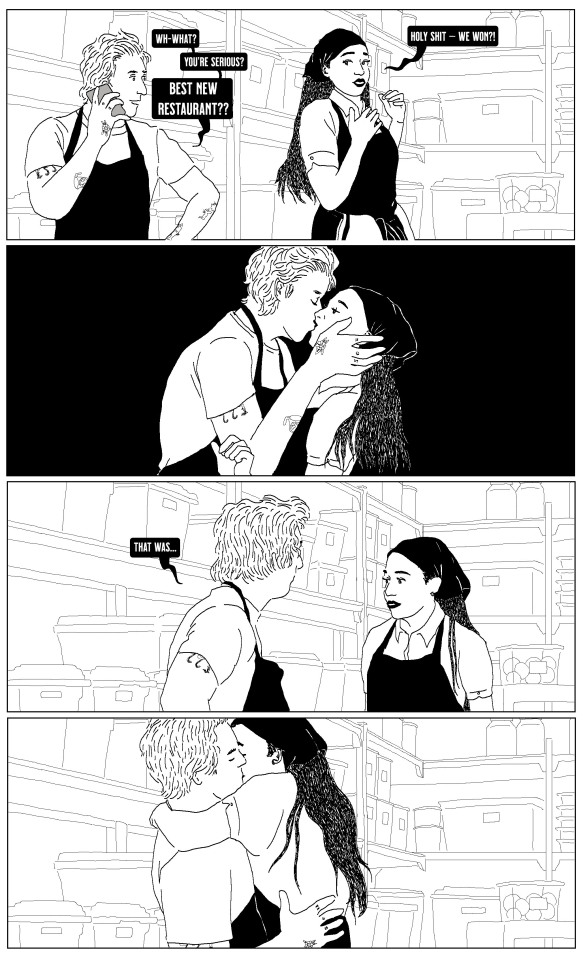
first (& second) kiss
#sydcarmy#syd x carmy#carmen x sydney#slow burn#the bear fanart#illustration#my art#artists on tumblr#art#black and white#fanart#lovers#then immediately after they did the rest of dinner service like nothing happened#but then went home together and kissed s'more minus clothes
298 notes
·
View notes
Text
It is, by far, way too funny to me how I've been confused about Karlach's inventory for god knows how long before realising what's wrong. I was convinced it was the game being bugged since she can carry like 250kg.
Then I realised... she's been carrying around Cazador's corpse all this time. This shit is so funny to me because can you imagine a group of 4 people walking around Baldur's Gate, just casually dragging the corpse of a vampire lord along with them as a sign of dominance (and forgetfulness of said vampire corpse).
#this is too fucking funny to me#how could i completely forget about this corpse in my inventory#astarion's probably thinking 'pls just let us leave this fuckhead in the blazing sun'#i tried this and nothing happened#then i just casually tucked him into my inventory again#karlach's thinking smth like 'pls let us burn him I hate carrying around enslavers'#so now that i know of this corpse's existence i begin plotting a fitting burial#and it's gonna be so disrespectful we'll all love it#i also took this fuckhead with me cause i usually loot such dumbasses naked and leave them laying but i wanted smth special#+ i couldn't loot his clothes#little fun fact: in actual life i truly arrange people's burials#baldur's gate 3#fun#karlach#bg3#astarion#baldurs gate 3#cazador szarr#baldurs gate iii#baldur's gate iii
152 notes
·
View notes
Text
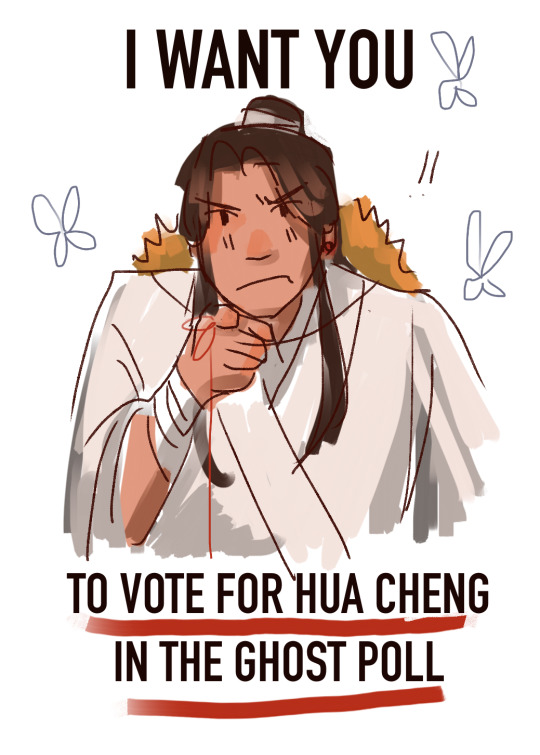
COME ON GUYS DON'T LET DIANXIA DOWN
#images i drew on my phone approximately 90 seconds before class started#tma vs tgcf is pitting two bad bitches against each other but#from the other guys propaganda he is apparently a beloved side character#which i totally understand.#BUT HUA CHENG IS THE DEUTERANTAGONIST WHO LOVED XIE LIAN SO MUCH IT UNDOOMED HIM FROM THE NARRATIVE#HE DIDNT CLAW HIS WAY OUT OF TONGLU TO BE BEATEN LIKE THIS#also tma has gay people that dont undoom each other from the narrative. L + ratio (/j/j/j/j we all love tragedies here)#hua cheng will never rest in peace and he doesn't want to because he has a smokin boyfriend#they are both angry goths but has gerry died THREE TIMES????? no. just once. lame.#gerry got his skin bound into a necromancy book that was eventually burned but hua cheng ripped out his eye to craft a sickass scimitar !!!#hua cheng haunts the narrative before he dies in a hundred tiny ways and then HEAVILY after he dies a second time#he's an awesome city owner and has violent beef with HEAVEN. and he carves statues and paints and builds temples#and is also a self conscious loser <3#his gay awakening was intensely traumatic and religious for everybody involved. and he's had the same life mission since he was 10#he is actively fighting ghost discrimination and getting dangerous magical items off of the normal human market#also he is always bedecked in elaborate silver and chains and eyeliner and ALWAYS in blood red clothes#HE CAN MAKE IT RAIN BLOOD!!???!?!? ALSO#he stick and poked his god's name on himself but his handwriting is so bad it's unrecognizable and the signs he puts up have evil auras#this has ceased to be propaganda. now im just gushing. only tgcf fans will see this anyway. whatever youre getting blorbo rant#tgcf#art#poll#hua cheng#lmao#my art#tian guan ci fu#hualian#xie lian#hob#heaven official's blessing
346 notes
·
View notes
Text
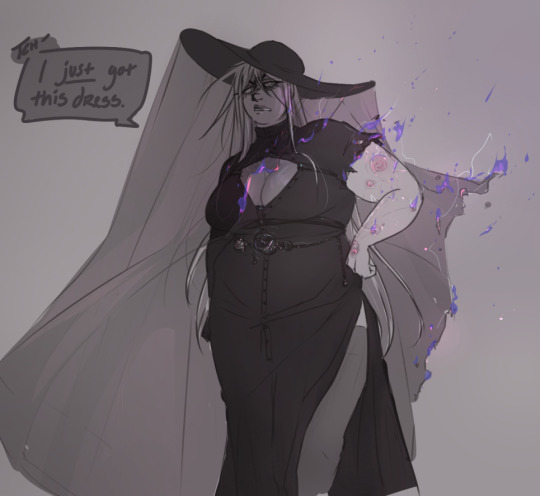
oh, that spell was supposed to hurt?
#my ocs#evangeline#she is a very powerful witch who is full of secrets#im sure whoever cast that attack practiced and practiced for DECADES#and all it did was singe her clothes#(legendary resistance burned) LOL#i just wanted to doodle today! and also my wife came up with the cool hat#big hat with long sheer fabric thats enchanted to protect her...#more another time good night friends!
161 notes
·
View notes
Note
I love werewolf Phoenix so much but
What about him with fire wings? Instead of needing a bike to go from scene to scene, Maya and him could just fly there, and his fear of heights despite being a bird hybird would be something he gets made fun of a lot. He can light his wings or have fire coming out of his finger + a higher heat resistance. Just imagining him and Maya flying around would be so funny
I love werewolf Phoenix so it's hard to decide how he'd fit in this au. Everyone asks him if he is a Phoenix bc that'd his name and when he says he's a werewolf he gets bullied

NO BECAUSE YOU’RE LITERALLY SO SMART 😭 featherweight fans know how much I love bird people
GRAHHHH I LOVE WEREWOLF NICK BUT I LOVE THIS TOO 😨😭💥
#doctorsiren#ace attorney#ace attorney au#phoenix wright#maya fey#silly little monster au#ace attorney fanart#art#digital art#my art#fanart#procreate#*SHAKES YOU*#since monsters are commonplace in this world he would easily have fire-resistant clothing#or maybe he can control if his fire burns certain stuff#that would be neat
232 notes
·
View notes
Text
oh, we're best friends? would you cannibalize me in the Canadian wilderness? marry my high school boyfriend and have his baby? sit across from my parents years after I died and relive how much you loved me? I don't even know where you end and I begin?
#shauna jackie#shauna shipman#jackie taylor#yellowjackets#save my homecoming dress from a burning house#try to kill the boy I lost my virginity to#prop up my dead corpse and play house#wear my clothes for warmth#hunt and cook my favorite animal for family dinner
214 notes
·
View notes
Text
"Growing flax to make linen was one of the oldest human activities in Europe, particularly in the Rhineland. Archeologists have found linen textiles among the settlements of Neolithic cultivators along the shores of Lake Neuchâtel in the Jura Mountains west of Bern, Switzerland. These were elaborate pieces: Stone Age clothmakers of the Swiss lakeshores sewed pierced fruit pits in a careful line into a fabric with woven stripes. The culture spread down the Rhine and into the lowland regions.
The Roman author Pliny observed in the first century AD that German women wove and wore linen sheets. By the ninth century flax had spread through Germany. By the sixteenth century, flax was produced in many parts of Europe, but the corridor from western Switzerland to the mouth of the Rhine contained the oldest region of large-scale commercial flax and linen production. In the late Middle Ages the linen of Germany was sold nearly everywhere in Europe, and Germany produced more linen than any other region in the world.
At this juncture, linen weavers became victims of an odd prejudice. “Better skinner than linen weaver,” ran one cryptic medieval German taunt. Another macabre popular saying had it that linen weavers were worse than those who “carried the ladders to the gallows.” The reason why linen weavers were slandered in this way, historians suspect, was that although linen weavers had professionalized and organized themselves into guilds, they had been unable to prevent homemade linen from getting onto the market. Guilds appeared across Europe between the twelfth and fifteenth centuries but many of the items they produced for exchange, like textiles and soap, were also produced at home right up through the nineteenth century. The intricate regulations of the guilds—determining who could join, how they would be trained, what goods they would produce, and how these could be exchanged—were mainly designed to distinguish guild work from this homely labor. That linen making continued to be carried out inside of households—a liability for guilds in general—lent a taint to the linen guild in particular.
In the seventeenth century, guilds came under pressure from a new, protocapitalist mode of production. Looking for cheaper cloth to sell on foreign markets, entrepreneurs cased the Central European countryside offering to pay cash to home producers for goods. Rural households became export manufacturing centers and a major source of competition with the guilds. These producers could undercut the prices of urban craftsmen because they could use the unregulated labor of their family members, and because their own agricultural production allowed them to sell their goods for less than their subsistence costs.
The uneasiness between guild and household production in the countryside erupted into open hostility. In the 1620s, linen guildsmen marched on villages, attacking competitors, and burning their looms. In February 1627 Zittau guild masters smashed looms and seized the yarn of home weavers in the villages of Oderwitz, Olbersdorf, and Herwigsdorf.
Guilds had long worked to keep homemade products from getting on the market. In their death throes, they hit upon a new and potent weapon: gender. Although women in medieval Europe wove at home for domestic consumption, many had also been guild artisans. Women were freely admitted as masters into
the earliest medieval guilds, and statutes from Silesia and the Oberlausitz show that women were master weavers. Thirteenth-century Paris had eighty mixed craft guilds of men and women and fifteen female-dominated guilds for such trades as gold thread, yarn, silk, and dress manufacturing. Up until the mid-seventeenth century, guilds had belittled home production because it was unregulated, nonprofessional, and competitive. In the mid-seventeenth century this work was identified as women’s work, and guildsmen unable to compete against cheaper household production tried to eject women from the market entirely. Single women were barred from independent participation in the guilds. Women were restricted to working as domestic servants, farmhands, spinners, knitters, embroiderers, hawkers, wet nurses. They lost ground even where the jobs had been traditionally their own, such as ale brewing and midwifery, by the end of the seventeenth century.
The wholesale ejection of women from the market during this period was achieved not only through guild statute, but through legal, literary, and cultural means. Throughout the sixteenth and seventeenth centuries women lost the legal right to conduct economic activity as femes soles. In France they were declared legal “imbeciles,” and lost the right to make contracts or represent themselves in court. In Italy, they began to appear in court less frequently to denounce abuses against them. In Germany, when middle-class women were widowed it became customary to appoint a tutor to manage their affairs. As the medieval historian Martha Howell writes, “Comedies and satires of this period…often portrayed market women and trades women as shrews, with characterizations that not only ridiculed or scolded them for taking on roles in market production but frequently even charged them with sexual aggression.” This was a period rich in literature about the correction of errant women: Shakespeare’s The Taming of the Shrew (1590–94), John Ford’s ’Tis Pity She’s a Whore (1629–33), Joseph Swetnam’s “The Araignment of Lewde, Idle, Froward, and Unconstant Women” (1615). Meanwhile, Protestant reformers and Counter-Reformation Catholics established doctrinally that women were inherently inferior to men.
This period, called the European Age of Reason, successfully banished women from the market and transformed them into the sweet and passive beings that emerged in Victorian literature. Women accused of being scolds were paraded in the streets wearing a new device called a “branks,” an iron muzzle that depressed the tongue. Prostitutes were subjected to fake drowning, whipped, and caged. Women convicted of adultery were sentenced to capital punishment.
As a cultural project, this was not merely recreational sadism. Rather, it was an ideological achievement that would have lasting and massive economic consequences. Political philosopher Silvia Federici has argued this expulsion was an intervention so massive, it ought to be included as one of a triptych of violent seizures, along with the Enclosure Acts and imperialism, that allowed capitalism to launch itself.
Part of why women resisted enclosure so fiercely was because they had the most to lose. The end of subsistence meant that households needed to rely on money rather than the production of agricultural goods like cloth, and women had successfully been excluded from ways to earn. As labor historian Alice Kessler-Harris has argued, “In pre-industrial societies, nearly everybody worked, and almost nobody worked for wages.” During the sixteenth and seventeenth centuries, monetary relations began to dominate economic life in Europe. Barred from most wage work just as the wage became essential, women were shunted into a position of chronic poverty and financial dependence. This was the dominant socioeconomic reality when the first modern factory, a cotton-spinning mill, opened in 1771 in Derbyshire, England, an event destined to upend still further the pattern of daily life."
- Sofi Thanhauser, Worn: A People's History of Clothing
#radical feminism#feminism#linen#history of clothing#sexism#female oppression#the rights they TOOK from us#i'm so pissed#i knew there would be misogyny in history of clothing#but this made my blood burn#Sofi Thanhauser
94 notes
·
View notes
Text
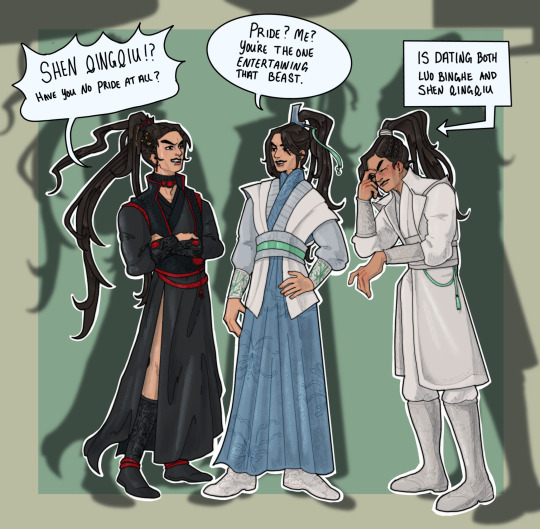
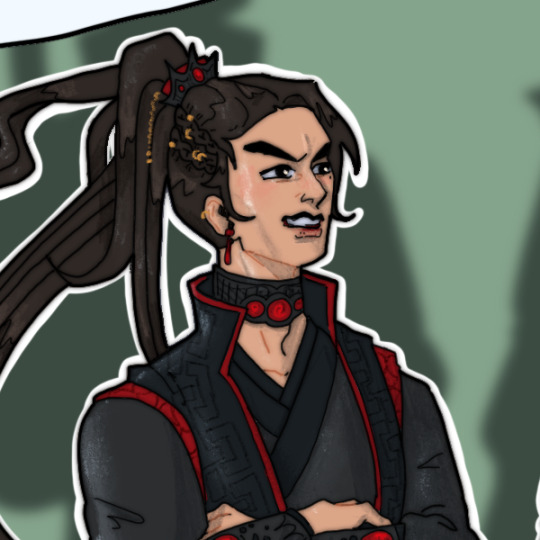
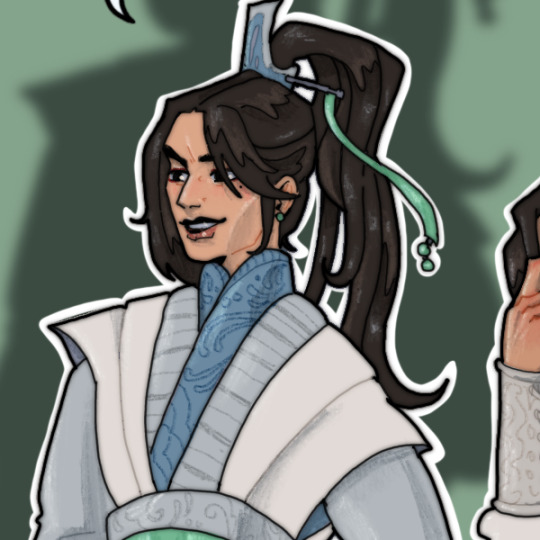

Liu Qingge date lineup… I was thinking about how funny it would be to see how dating might change your lifestyle
#kamaetedraws#svsss#liu qingge#bingliu#liujiu#bingliushen#(implied)#svsss lqg never gets in on the fashion party bc lbh and sqq are too busy spoiling each other#liujiu lqg's hair is better taken care of bc sqq does that for him. sqq doesnt like braids tho#liujiu lqg also has The Most decked out clothes bc sqq embroiders them when he is feeling petty#he likes hiding bamboo motifs and chrysanthemums#lqg doesnt care except when he does in which case he vacillates wildly between#'haha look how much sqq wants to show me off' and 'UGH can he NOT leave my clothes alone for ONE second'#bingliu lqg has servants who bully him into taking care of everything he normay ignores so that's why his hair is longer#lbh replaced his whole wardrobe with Bingge Colors and burned all the cqms stuff#AND he is always giving lqg fancy fiddly little gifts of jewelry and stuff#lqg doesnt actually care for it but he's gotten better at manipulating so he sometimes wears it as a bribe#bingliushen lqg is SO embarassed right now and is thinking about hiding his little bingqiu belt tassle so he doesnt get dragged into this#(but he is obviously coming out winning.#HE still has his principles he tells himself HE still dresses his own damn self HE isnt so fussy and self absorbed about his relationship#he is a little jealous)
113 notes
·
View notes
Text

Another sandrock scribble in between BnR and comm work- i really like her peacock hair color ngl
#my time at sandrock#builder oc#she's just peacock themed in theory. also this isnt her actual outfit idek what itd be but when i sketched her i just put her in her undies#n then thought itd be weird ot post that so i quickly scribbled on clothes#idk#anyway she's an burned out/retired idol who crawled to sandrock and its all been downhill from there jsdlkfje#i will likely recycle her for a mini comic or smth at some point#i like her a lot ok#doodles
102 notes
·
View notes
Text

Let go
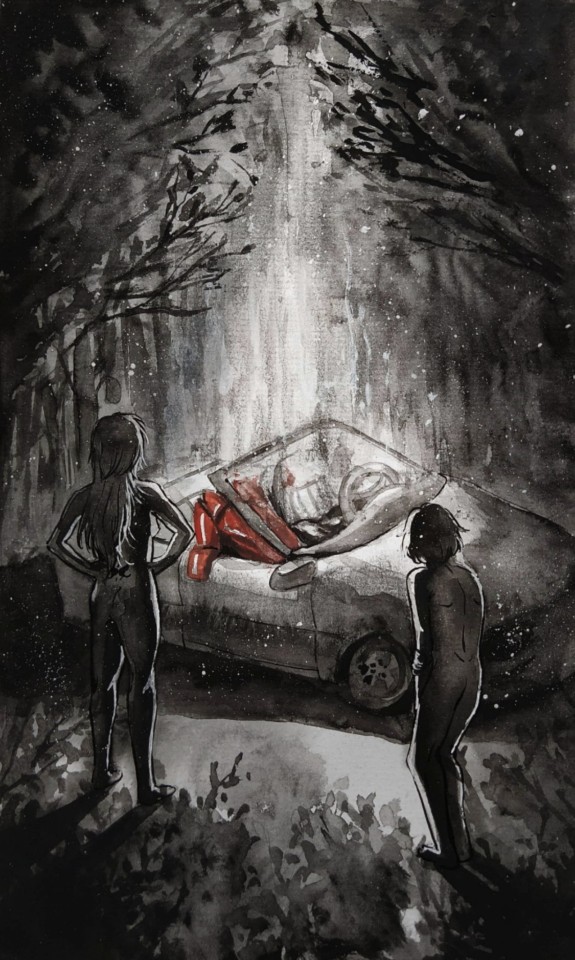
#fem fight club#*marvels at burning vehicle* hey man this looks pretty good man- *turns to see two butt ass naked lesbians* where your clothes at?#fight club#soapshipping#tbh i thought that my impostor syndrome would never leave me alone to get these over with
105 notes
·
View notes
Text

specter
#horizon forbidden west#hfw#burning shores#hfwbs#aloy#fun with the black bg from The Spot#yellow isn't normally my favorite color for clothing but i think this dye on the quen armor looks v snazzy#my skintone means i look like a starved victorian child dying of consumption if i wear yellow. which may be a source of my dislike of it...#thankfully aloy doesn't have that problem!
67 notes
·
View notes
Text

#me#i hate cold weather#i hate layering#i hate restrictive clothing#im grumpy about it#i miss summer#i miss getting 2nd degree burns from my seat belt#i miss walking outside and feeling my skin sizzle like bacon
71 notes
·
View notes
Text
Matthias!! I hate drawing him:D!!!!

#This is my first time drawing him#I tried drawing him in modern clothing#A mistake :)#And then I gave him side burns#Because it just looks better#He doesn't look right to me without them#Also ignore how uneven his eyes are in the middle drawing:|#ikepri#ikepri matthias#ikemen prince#ikemen fanart#ikepri modern au#modern au#arsons art :p#Queue#I've pushed back this drawing like three times so I could post a few other things early#Oh my God#Will he ever be posted?#Stay tuned!#Matthias first put on queue to be posted the 22nd#When will he actually be posted?#Unknown
35 notes
·
View notes